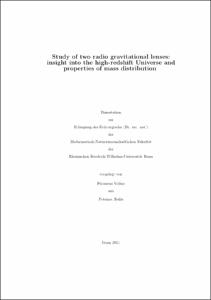Volino, Filomena: Study of two radio gravitational lenses : insight into the high-redshift Universe and properties of mass distribution. - Bonn, 2011. - Dissertation, Rheinische Friedrich-Wilhelms-Universität Bonn.
Online-Ausgabe in bonndoc: https://nbn-resolving.org/urn:nbn:de:hbz:5N-26489
Online-Ausgabe in bonndoc: https://nbn-resolving.org/urn:nbn:de:hbz:5N-26489
@phdthesis{handle:20.500.11811/5040,
urn: https://nbn-resolving.org/urn:nbn:de:hbz:5N-26489,
author = {{Filomena Volino}},
title = {Study of two radio gravitational lenses : insight into the high-redshift Universe and properties of mass distribution},
school = {Rheinische Friedrich-Wilhelms-Universität Bonn},
year = 2011,
month = oct,
note = {Similarly to a magnifying glass, a gravitational field deflects light rays that travel through it. This phenomenon, predicted by the theory of General Relativity by A. Einstein (1915), is referred to as gravitational lensing, and it is the core of the projects presented in this thesis. The study of gravitational lenses yields the mass distribution of the lensing object together with the properties of the background source. We have studied two of these systems using radio interferometers, achieving angular resolution within the range 0.001-4 arcseconds. The first system is the 8 o'clock arc (J002240+143130). Main goal is the detection of radio emission from a high redshift source exploiting lensing as natural telescope; eventually the properties of the intervening mass could then be studied from the observed lensed configuration. The second system is the gravitational lens MG J0414+0534. The goal is to deduce the properties of the foreground mass distribution and the background source. After three introductory chapters, in which we describe the theory behind this work and the techniques used to analyze the data and perform the modeling, in the last three chapters we discuss the two projects and outline the outlook of this work.},
url = {https://hdl.handle.net/20.500.11811/5040}
}
urn: https://nbn-resolving.org/urn:nbn:de:hbz:5N-26489,
author = {{Filomena Volino}},
title = {Study of two radio gravitational lenses : insight into the high-redshift Universe and properties of mass distribution},
school = {Rheinische Friedrich-Wilhelms-Universität Bonn},
year = 2011,
month = oct,
note = {Similarly to a magnifying glass, a gravitational field deflects light rays that travel through it. This phenomenon, predicted by the theory of General Relativity by A. Einstein (1915), is referred to as gravitational lensing, and it is the core of the projects presented in this thesis. The study of gravitational lenses yields the mass distribution of the lensing object together with the properties of the background source. We have studied two of these systems using radio interferometers, achieving angular resolution within the range 0.001-4 arcseconds. The first system is the 8 o'clock arc (J002240+143130). Main goal is the detection of radio emission from a high redshift source exploiting lensing as natural telescope; eventually the properties of the intervening mass could then be studied from the observed lensed configuration. The second system is the gravitational lens MG J0414+0534. The goal is to deduce the properties of the foreground mass distribution and the background source. After three introductory chapters, in which we describe the theory behind this work and the techniques used to analyze the data and perform the modeling, in the last three chapters we discuss the two projects and outline the outlook of this work.},
url = {https://hdl.handle.net/20.500.11811/5040}
}






